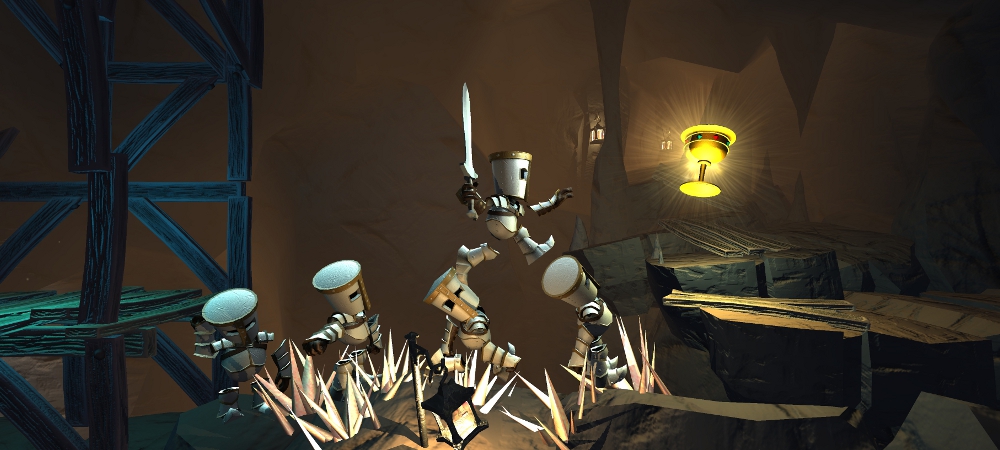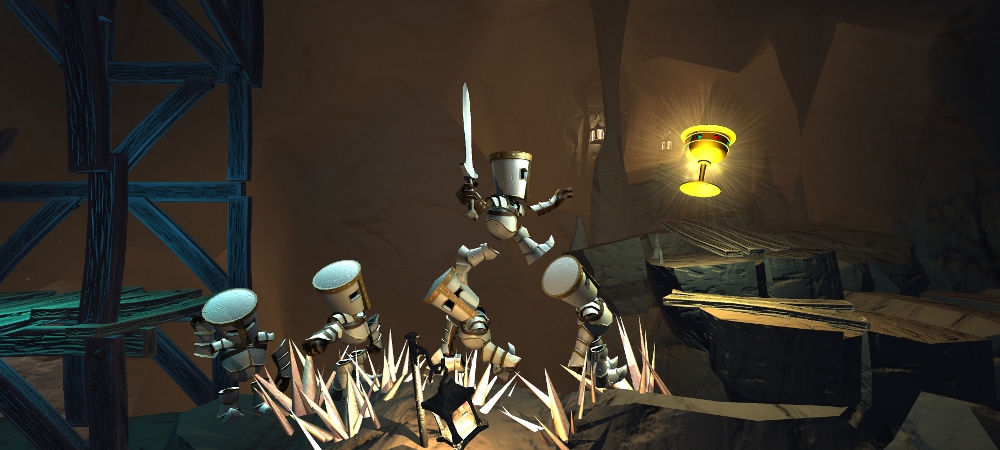In war, there are casualties
In most games, as in the real world, death is something to be avoided. Often it is a learning experience, but that is used to teach how not to die next time. In Life Goes On, the gameplay centers on death, but its approach is one of utility and necessity. One man may die in order for others to succeed in the future.
As a puzzle platformer, the idea appears a bit shallow at first, but it leverages some great game design tenets to stay fresh throughout the experience. Though it begins with the simple concept of using dead bodies as stepping stones to cross spike pits, it is constantly introducing new puzzle elements to play with across its dense campaign.

Life Goes On (Linux, Mac, PC [reviewed])
Developer: Infinite Monkeys Entertainment
Publisher: Infinite Monkeys Entertainment
Released: April 17, 2014
MSRP: $12.99
Rig: AMD Phenom II X2 555 @ 3.2 GHz, with 4GB of RAM, ATI Radeon HD 5700, Windows 7 64-bit
Life Goes On tells the tale of a powerful monarch searching for the Cup of Life. As the ruler of many, he has countless knights to send on the quest. In fact, he has so many knights that each one is expendable.
Every level in Life Goes On holds a chalice to collect, but each is insurmountable for just one of the hapless knights. Obstacles like spike pits, circular saws, and locked doors block progress toward the goal, and the path to victory is often straight through them, dying in the process and paving the way for the next knight in line.
Through impalement on a spike pit, the next knight can step on the body to safely cross to the other side. By dying on top of a pressure plate, a knight can hold the door open for others. After being frozen into a giant ice cube, another knight can block a flamethrower.
The strength of Life Goes On is that new traps and tools are introduced throughout the game. Just when it seems like the ideas that result from the available set of items are exhausted, something new appears. After spikes come pressure switches, after pressure switches comes fire, after fire comes ice, and so on.
Later on, electrical switches require a knight (or more accurately, a knight’s metallic armor) in place to close the circuit and execute an action. Entering the circuit will electrocute and kill any knight, and some puzzles revolve around killing the right knight at the right time, or removing a dead body from a circuit with fire or magnets.
One of the last puzzle elements introduced is a switch that is tied to a single life. If a knight touches it, the switch remains active so long as that knight does. Once again, it provides unique situations for strategic suicide.

The game is divided into three main areas: the Mines, the Mountain, and the Castle. Since new elements are introduced throughout, the areas themselves do not provide much division as far as gameplay is concerned, but the puzzles do tend to get more complicated as the player progresses. Each area has between 16 and 19 levels, for a total of more than 50 levels.
Truly, it could be counted as more than that, because several levels are made up of two or three discrete puzzles. At the end of each section, there is a longer, more cinematic level, and although they are presented as being more action oriented and time sensitive, they are still generally made up of puzzles to solve with no time constraint.
That said, each level does have a set of bonus objectives past collecting the goblet, one of which is a par time. There are also awards for completing a level under a certain number of deaths and for doing so with the absolute minimum number of casualties. Lastly, there is a cute monster named Jeff who eats knights (alive or dead) hidden in every level, and feeding him is the last optional objective to complete.

In all, it takes two to three hours to reach the end of Life Goes On without worrying about optional objectives, but that figure doubles for those willing to put in the effort to complete each level with top marks. It is not overly difficult, but going for the best times and awards will test the player’s creative reasoning and raw platforming skill at times. Dropping a carpet of bodies on a spike pit may make crossing easy, but using a single dead knight as an island takes more finesse.
The overall presentation is a bit generic, but functional. Although the art style and music will not amaze anybody, they fit the theme of an ego-inflated monarch well enough, and the bright colors used for traps and switches convey how a particular level works without much confusion. One nice little touch is the dark humor inserted; most victory screens poke fun at the fact that some knights needed to die in order to achieve it. Additionally, the playable credits sequence is one of the funniest in recent memory.
Life Goes On might not start with the most mindblowing hook, but the idea is solid and Infinite Monkeys develops it well. By constantly adding new tricks into its repertoire and not dragging itself out unnecessarily, it maintains a good quality throughout. Puzzle difficulty ranges from easy to medium-hard; it rarely gets diabolically difficult, and when it does it is only when completing optional objectives. Although it is not particularly nice to look at, the underlying gameplay is worthwhile for any puzzle platformer enthusiast.





